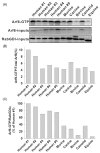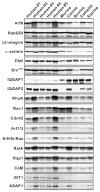Protein expression in platelets from six species that differ in their open canalicular system
- PMID: 20196629
- PMCID: PMC3982968
- DOI: 10.3109/09537101003611385
Protein expression in platelets from six species that differ in their open canalicular system
Abstract
Platelets contain an invaginated, tubular membranous structure called the surface-connected open canalicular system (SCCS or OCS), which is contiguous with the plasma membrane and serves as a site for granule fusion and as a reservoir of membrane for platelet spreading. According to ultrastructural studies, platelets from some species lack OCS. In an attempt to correlate biochemical and functional attributes with the presence of an OCS, platelets from human, mouse and dog (OCS(+)), and from cow, camel and horse (OCS(-)) were analysed for differential protein expression and aggregation in response to thrombin. Among the 18 different cytoskeletal and regulatory proteins examined, five (Rac1, RhoA, Ras, calmodulin and Src) were expressed at higher levels in OCS(+) platelets (p < 0.05). Given the role of Arf6 in the formation of tubular invaginations in nucleated cells, the levels of Arf6-GTP were analysed in OCS(+) and OCS(-) platelets. There was no significant correlation between the presence of OCS and total Arf6 or Arf6-GTP levels. Comparison of platelet aggregation between different species suggests that OCS(-) platelets have delayed responses. This comparison of platelets from six different species, which differ in their OCS, shows the differential expression of known signaling components and foreshadows future studies focusing on OCS formation and function.
Conflict of interest statement
The authors have no financial conflicts and thus nothing to disclose.
Figures



Similar articles
-
Platelet membrane variations and their effects on δ-granule secretion kinetics and aggregation spreading among different species.Biochim Biophys Acta. 2015 Jul;1848(7):1609-18. doi: 10.1016/j.bbamem.2015.04.006. Epub 2015 Apr 20. Biochim Biophys Acta. 2015. PMID: 25906946 Free PMC article.
-
Primary platelet signaling cascades and integrin-mediated signaling control ADP-ribosylation factor (Arf) 6-GTP levels during platelet activation and aggregation.J Biol Chem. 2008 May 2;283(18):11995-2003. doi: 10.1074/jbc.M800146200. Epub 2008 Mar 7. J Biol Chem. 2008. PMID: 18326492 Free PMC article.
-
The ultrastructure of camel blood platelets: a comparative study with human, bovine, and equine cells.Platelets. 2008 Feb;19(1):51-8. doi: 10.1080/09537100701627151. Platelets. 2008. PMID: 18231938
-
Structure and function of the open canalicular system - the platelet's specialized internal membrane network.Platelets. 2018 Jun;29(4):319-325. doi: 10.1080/09537104.2018.1431388. Epub 2018 Feb 14. Platelets. 2018. PMID: 29442528 Review.
-
The molecular basis of platelet biogenesis, activation, aggregation and implications in neurological disorders.Int J Neurosci. 2020 Dec;130(12):1237-1249. doi: 10.1080/00207454.2020.1732372. Epub 2020 Feb 26. Int J Neurosci. 2020. PMID: 32069430 Review.
Cited by
-
Alterations in platelet secretion differentially affect thrombosis and hemostasis.Blood Adv. 2018 Sep 11;2(17):2187-2198. doi: 10.1182/bloodadvances.2018019166. Blood Adv. 2018. PMID: 30185436 Free PMC article.
-
Physiological factors affecting platelet-rich plasma variability in human and veterinary medicine.Front Vet Sci. 2025 May 21;12:1571373. doi: 10.3389/fvets.2025.1571373. eCollection 2025. Front Vet Sci. 2025. PMID: 40470272 Free PMC article. Review.
-
Platelets: still a therapeutical target for haemostatic disorders.Int J Mol Sci. 2014 Oct 7;15(10):17901-19. doi: 10.3390/ijms151017901. Int J Mol Sci. 2014. PMID: 25295482 Free PMC article. Review.
-
Platelet membrane variations and their effects on δ-granule secretion kinetics and aggregation spreading among different species.Biochim Biophys Acta. 2015 Jul;1848(7):1609-18. doi: 10.1016/j.bbamem.2015.04.006. Epub 2015 Apr 20. Biochim Biophys Acta. 2015. PMID: 25906946 Free PMC article.
-
Animal Models of Neointimal Hyperplasia and Restenosis: Species-Specific Differences and Implications for Translational Research.JACC Basic Transl Sci. 2021 Aug 11;6(11):900-917. doi: 10.1016/j.jacbts.2021.06.006. eCollection 2021 Nov. JACC Basic Transl Sci. 2021. PMID: 34869956 Free PMC article. Review.
References
-
- Klinger MH. The storage lesion of platelets: Ultrastructural and functional aspects. Ann Hematol. 1996;73:103–112. - PubMed
-
- Leistikow EA. Platelet internalization in early thrombogenesis. Semin Thromb Hemost. 1996;22:289–294. - PubMed
-
- Behnke O. Coated pits and vesicles transfer plasma components to platelet granules. Thromb Haemost. 1989;62:718–722. - PubMed
-
- Kudo S, Onai H, Ogawa R. Response of blood cells to hemorrahagic shock in the dog. J Anesth. 1987;1:51–61. - PubMed
Publication types
MeSH terms
Substances
Grants and funding
LinkOut - more resources
Full Text Sources
Research Materials
Miscellaneous
